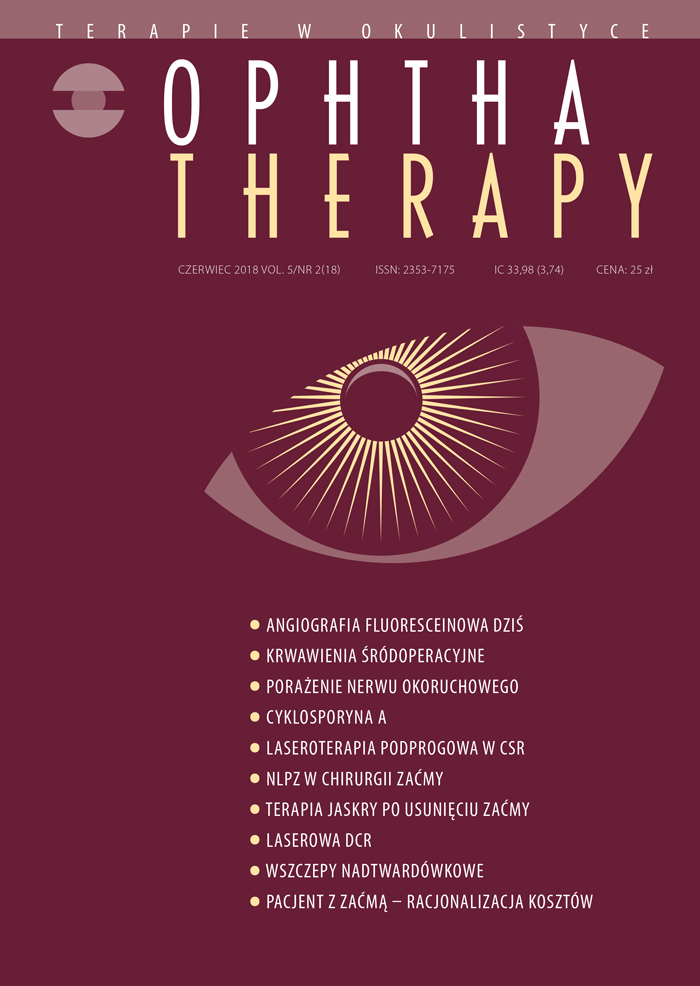Racjonalność postępowania zachowawczego w przypadku jaskry po operacji usunięcia zaćmy
##plugins.themes.bootstrap3.article.main##
Abstrakt
Według danych WHO jaskra jest drugą po zaćmie najczęstszą przyczyną znacznego obniżenia ostrości wzroku oraz wiodącą przyczyną ślepoty. W starzejącym się społeczeństwie rośnie liczba chorych leczonych z powodu jaskry, którzy wymagają przeprowadzenia operacji usunięcia zaćmy. Fakoemulsyfikacja z wszczepieniem sztucznej soczewki jest obecnie powszechnie stosowaną procedurą usunięcia zmętniałej soczewki. Chociaż badania sugerują pooperacyjny spadek ciśnienia wewnątrzgałkowego u wielu pacjentów po operacji zaćmy, stopień jego redukcji zależy od jej przedoperacyjnej wartości w oczach z nadciśnieniem wewnątrzgałkowym i jaskrą. Nie należy zapominać o ryzyku przemijającego wzrostu ciśnienia wewnątrzgałkowego we wczesnym okresie pooperacyjnym, który może wymagać dodatkowego, intensywnego leczenia.
Pobrania
##plugins.themes.bootstrap3.article.details##

Utwór dostępny jest na licencji Creative Commons Uznanie autorstwa – Użycie niekomercyjne – Bez utworów zależnych 4.0 Międzynarodowe.
Copyright: © Medical Education sp. z o.o. License allowing third parties to copy and redistribute the material in any medium or format and to remix, transform, and build upon the material, provided the original work is properly cited and states its license.
Address reprint requests to: Medical Education, Marcin Kuźma (marcin.kuzma@mededu.pl)
Bibliografia
2. Guan H, Mick A, Porco T et al. Preoperative factors associated with IOP reduction after cataract surgery. Optom Vis Sci. 2013; 90(2): 179-84. https://doi.org/10.1097/OPX.0b013e31827ce224.
3. Hayashi K, Hayashi H, Nakao F et al. Effect of cataract surgery on intraocular pressure control in glaucoma patients. J Cataract Refract Surg. 2001; 27(11): 1779-86.
4. Tham CC, Leung DY, Kwong YY et al. Effects of phacoemulsification versus combined phaco-trabeculectomy on drainage angle status in primary angle closure glaucoma (PACG). J Glaucoma. 2010; 19(2): 119-23. https://doi.org/10.1097/IJG.0b013e31819d5d0c.
5. Poley BJ, Lindstrom RL, Samuelson TW et al. Intraocular pressure reduction after phacoemulsification with intraocular lens implantation in glaucomatous and nonglaucomatous eyes: evaluation of a causal relationship between the natural lens and open-angle glaucoma. J Cataract Refract Surg. 2009; 35(11): 1946-55. https://doi.org/10.1016/j.jcrs.2009.05.061.
6. Wang N, Chintala SK, Fini ME et al. Activation of a tissue-specific stress response in the aqueous outflow pathway of the eye defines the glaucoma disease phenotype. Nat Med. 2001; 7(3): 304-9.
7. Meyer MA, Savitt ML, Kopitas E. The effect of phacoemulsification on aqueous outflow facility. Ophthalmology. 1997; 104(8): 1221-7
8. Dayanir V, Ozcura F, Kir E et al. Medical control of intraocular pressure after phacoemulsification. J Cataract Refract Surg. 2005; 31(3): 484-8.
9. Byrd S, Singh K. Medical control of intraocular pressure after cataract surgery. J Cataract Refract Surg. 1998; 24(11): 1493-7.
10. Borazan M, Karalezli A, Akman A et al. Effect of antiglaucoma agents on postoperative intraocular pressure after cataract surgery with Viscoat. J Cataract Refract Surg. 2007; 33(11): 1941-5.
11. Rainer G, Menapace R, Findl O et al. Effect of a fixed dorzolamide-timolol combination on intraocular pressure after small-incision cataract surgery with Viscoat. J Cataract Refract Surg. 2003; 29(9): 1748-52.
12. Georgakopoulos CD, Makri OE, Plotas P et al. Brinzolamide-timolol fixed combination for the prevention of intraocular pressure elevation after phacoemulsification. Clin Exp Ophthalmol. 2013; 41(7): 662-7. https://doi.org/10.1111/ceo.12092.
13. Ozkurt Y, Oral Y, Karacan O et al. Comparison of the effects of dorzolamide-timolol fixed combination and brimonidine on intraocular pressure after phacoemulsification surgery. Eye Contact Lens. 2008; 34(1): 21-3. https://doi.org/10.1097/ICL.0b013e3180587e0a

